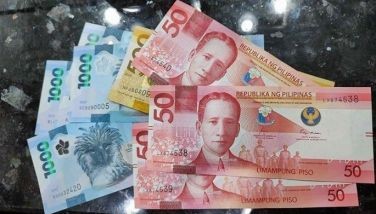Is the peso weak?
Many of our readers and investors are concerned and are asking: “Why is the peso weak? Will it continue to depreciate against the dollar?” The peso is now at 45.78 and is trading at 5-year lows. But before making any conclusions, let us first look at how the dollar has fared against major currencies and against currencies in the region.
US dollar trend remains solidly up
Since bottoming out in 2011, the US dollar index has already strengthened by 34.2 percent. The past year alone saw the pace of US dollar appreciation quicken as central bank policies started to diverge in the 2nd half of 2014. The Fed has been hinting at a rate increase starting last year as the US economy strengthens, while other CBs are still in easing mode as their respective economies continue to struggle.
Dollar against major currencies
Policy divergence bets guided the US dollar higher against the Japanese yen and the euro. From its post-2009 peak of 75.77, the yen has lost 64.8 percent against the greenback. Meanwhile, the euro has depreciated 28 percent from a post-2009 peak of 1.512.
The US dollar likewise sharply gained against commodity currencies as commodity prices collapsed to multi-year lows after peaking in 2011. The Canadian dollar and the Australian dollar have declined 39.9 percent and 33.7 percent, respectively, from their post-2009 highs against the US dollar.

Source: Bloomberg, Wealth Securities Research
Commodity prices reach multiyear lows
The sharp rise of the US dollar also caused commodity prices to drop, thereby weakening the currencies of commodity producers. Today, crude oil, copper, aluminum and zinc have slumped to six-year ows. And prices of soft-commodities such as corn, wheat, soybean, sugar, coffee and rice are at fresh multi-year lows.
In addition, the slowdown of growth in China whose GDP is expected to grow at seven percent this year (the lowest level in nearly a quarter of a century) has also manifested in lower commodity prices. China has a huge influence in commodities market since it is the world’s biggest importer of crude oil and accounts for nearly half the global demand for nickel, aluminum and copper.
EM commodity currencies under pressure
Given the backdrop of a strong dollar and lower global demand for commodities, emerging market economies heavily dependent on commodity exports suffered worse. Note the Russian ruble and Brazilian real which has depreciated more than 100 percent against the US dollar from their post-2009 highs. Economic sanctions in Russia has compounded the decline in the ruble, while populist misrule in Brazil has further aggravated the Brazilian real.
Other top commodity exporters such as South Africa, Indonesia, Chile and Malaysia have likewise experienced sharp declines in their currencies. These economies rely a lot on their exports to shore up their current account and growth.

Source: Bloomberg, Wealth Securities Research
Socialist utopias, military conflicts & hyperinflation
Making up the bottom are the currencies of socialist utopias suffering from hyperinflation such as the Argentine peso and Venezuelan bolivar. Since the early 2000s, the Argentine peso has weakened more than 800 percent against the greenback while the bolivar has weakened 500 percent.
But the worst performing in recent years are the Belorussian ruble and Ukraine hryvnia, two currencies economically and politically tied to the Russian ruble. Military conflict and economic sanctions in the region have led to capital outflows and sky-high inflation.

Source: Bloomberg, Wealth Securities Research
The peso in proper perspective
Putting things in proper perspective, the peso has actually been one of the more stable currencies in a strong-dollar environment. Year-to-date, the peso has weakened by only 2.1 percent against the greenback compared to the 5.1 percent depreciation among Asian currencies and 6.9 percent decline among major currencies.

Source: Bloomberg, Wealth Securities Research
One of the strongest currencies these past few years
In fact, the peso is one of the strongest currencies in Asia and the world these past few years. Asian currencies have lost 25.9 percent and major currencies have fallen 35.2 percent on average since the dollar bottomed out in 2011. In comparison, the peso has only lost 12.9 percent since reaching a post-2009 peak of 40.54.
In other words, the peso actually appreciated against most other currencies in recent years with the exception of the US dollar and a few other currencies such as the Chinese yuan which is basically pegged to the US dollar.
Dollar strength, not peso weakness
So, is the peso really weak? Yes it is weaker, but it is mainly because of the strong dollar as we have written many times in the past (see It’s the Strong Dollar, Stupid!, June 24, 2013, It’s the Strong Dollar, Stupid! – Part 2, Oct. 6, 2014 and Philippine Peso: A Haven of Stability, Feb. 2, 2015).
It is really the result of broad-based dollar strength and not peso weakness which is causing the depreciation of the peso. The peso cannot afford to “stick out like a sore thumb” when all other currencies are depreciating against the dollar.
Opportunity of a Lifetime – The Book as template
For those who have read Opportunity of a Lifetime – The Book, you will be able to see our thesis and learn our thought process with regard to currencies. You will see how we came to conclude the peso bottomed out in 2005 (Chapter 6 – Calling the Bottom of the Peso). You will read why we believe the peso topped out at 40 back in 2013 (Chapter 7 – Peso Tops Out). By reading the book you will also learn why we now think there is increasing likelihood the peso could weaken or consolidate near the high end of its sweet spot (42 to 46 vs. the dollar).
Hopefully our readers can use the book, together with the archived articles of Philequity Corner, as guides to learn and absorb our thoughts on the peso, the dollar, other currencies and the stock market.
We are very happy with the sale of our book, Opportunity of a Lifetime. We may soon have to do a 2nd printing as books in the 1st printing are fast running out. We are sorry to announce the books are not yet available at the National Bookstore as previously announed. The remaining books are only available at Fully Booked and at the Philequity office.
Philequity Management is the fund manager of the leading mutual funds in the Philippines. Visit www.philequity.net to learn more about Philequity’s managed funds or to view previous articles. For inquiries or to send feedback, please call (02) 689-8080 or email [email protected].
- Latest
- Trending































